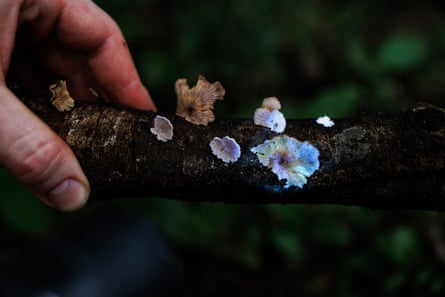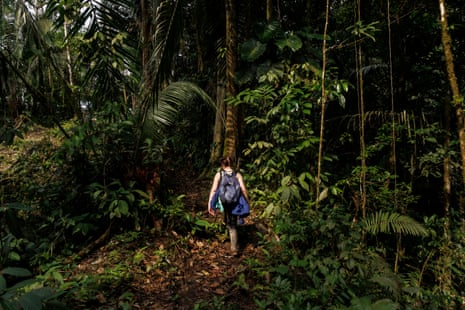Life, death and zombie mushrooms: searching for the Amazon’s rarest fungi – Guardian

Twilight is falling within the Ecuadorian jungle when the 2 scientists self-discipline their first zombie. The odor of damp earth and vegetation rises as Alan Rockefeller takes unhurried, careful steps, scanning the woodland flooring with an ultraviolet light.
Without observe, a fragment of undergrowth glows: strands of sparkling cordyceps, turned fluorescent by the torch. Dubbed the “zombie fungus”, cordyceps is primary for colonising its insect hosts compelling them to gape a simply self-discipline to launch spores. That is the self-discipline where the host will die.




-
Clockwise from top left: the team procure a Cordyceps nidus, a species demonstrate in 2017 that fruits on a trapdoor spider; Rockefeller illuminates a Cookeina speciosa; next, he holds up a stick on which Schizophyllum commune grow, an on a typical foundation mushroom that glows in UV light; Rockefeller and Quark demonstrate four monkey combs
Mandie Quark kneels within the wet, spongy earth, fastidiously digging her fingers around the entomopathogenic fungus to unveil the insect nestled below the outside: a thumb-sized beetle. The pair fastidiously light and photograph their procure ahead of origin their two-mile gallop dwelling.
Here within the mountains of Ecuador, the 2 mycologists possess launched into a research expedition within the unprotected rainforests of the greater Amazon. Their mission is to meticulously doc a few of the enviornment’s rarest fungi, which possess been without observe declining attributable to changes in climate, unlawful logging and mining.

-
Quark goes searching for uncommon and undiscovered fungi within the Indigenous land of the Sacha Wasi team in Pastaza, Ecuador
The Amazon rainforest brims with a few of the enviornment’s most diverse natural world. Limitless species of fungi dot the landscape, many aloof unnamed and searching at for discovery. Rockefeller and Quark fastidiously net info by photographing and cataloguing every specimen for submission to the nationwide herbarium in Quito and eventual DNA sequencing.
Rockefeller and Quark’s ideal operate is to share their discoveries about Amazonian fungi with the enviornment, serving to ecological conservation efforts in Ecuador and beyond. They work alongside the Indigenous Sacha Wasi team, who possess invited the scientists to characteristic on their land, exchanging knowledge on diverse fungi species and their culinary or ecological capacity.






-
High: Rockefeller scours a rainforest dirt wall for mushrooms. Center allotment, clockwise from top left: Quark holds up a extremely effective handheld light; captures a marasmius pinwheel mushroom in her lens; Rockefeller devices up two lights to capture Clavaria schaefferi; Quark photos Ophiocordyceps melolonthae. Above: Rockefeller is joined in his work by two ladies folk from the Sacha Wasi team
At the core of the map lies the art of myco-photography. Every click of the shutter is an attempt to capture a fleeting moment within the cycle of these fragile organisms, which spend most of their life underground. “My operate is to plan cease the most classic photo that that you just would possibly perchance well be in a series to imagine to net other folks alive to by biodiversity and create them are searching to study extra about mushrooms,” Rockefeller says.
The pair’s techniques consist of macro photography with point of curiosity stacking, a map that captures every intricate detail of a mushroom, to boot to recording the microscopy of the spores and generating DNA “barcode info”. By this form, they operate to be obvious every recorded mushroom contributes to the most up-to-date realizing of fungal biodiversity.

-
Rockefeller continues the painstaking hunt while Quark devices up one more photograph for his or her info
“Attractive what that you just would possibly perchance well want is basically crucial for conservation,” Rockefeller says. “It’s likely you’ll be in a series to’t correct inform that you just would possibly perchance well want a uncommon unnamed mushroom – that doesn’t work.
“While you happen to’ll be in a series to present it a name, then you definately’ll be in a series to preserve it. And if other folks are going to procedure chemical prognosis to are attempting to create a current discovery based mostly fully totally on these fungi, they want a name they’ll spend to focus on which fungus they’re the spend of. So taxonomy is basically crucial for that reason.”

-
The fruits of their labour: Rockefeller exhibits his series box of specimens demonstrate within the rainforest
Most other folks would possibly perchance well perchance also simply no longer ever possess the opportunity to focus on with the rainforest and peep these diverse and elusive fungi, so Rockefeller and Quark possess been sharing their findings on social media and app-based mostly fully mostly platforms, equivalent to iNaturalist, Mushroom Observer, GenBank, and MycoMap, to permit others to scrutinise the intricate crucial points – in some cases, ahead of the species vanish.
Whereas navigating though-provoking Amazonian terrain, they operate to launch a window to the giant capacity of fungi, and the importance of maintaining irreplaceable ecosystems.




-
Support at defective, the duo embark on the map of sorting and labelling the samples from their day’s work ahead of inserting them within the dehydrator. As soon as total, the valuable haul shall be taken to the nationwide herbarium in Quito
“It is though-provoking to halt within the demonstrate moment for the time being – we continuously possess a million issues searching to rob our attention,” Quark says. “But the work we are doing is drawing attention to the here and now, and upsetting others to procedure the identical.”
She provides: “Mushrooms exist on the precipice of life and death. They remind us that existence is fleeting, and our human journey will likely be fleeting. Being there on the most effective moment to search out a stunning mushroom, it is top to aloof be demonstrate in all of your senses to take care of that blip in time when the mushroom is at its most pristine.”

-
‘Strive and be demonstrate in all of your senses’: Quark examines a mushroom on a rainforest wall beside a waterfall
Safe extra age of extinction coverage here, and apply biodiversity journalists Phoebe Weston and Patrick Greenfield on X for your total most up-to-date info and aspects

